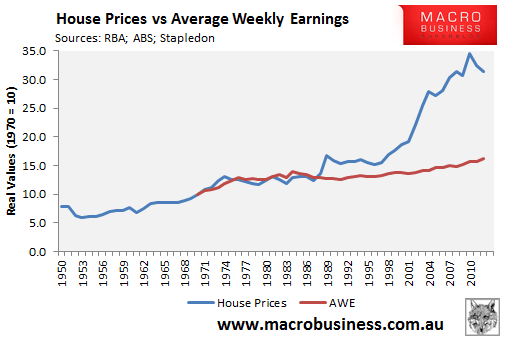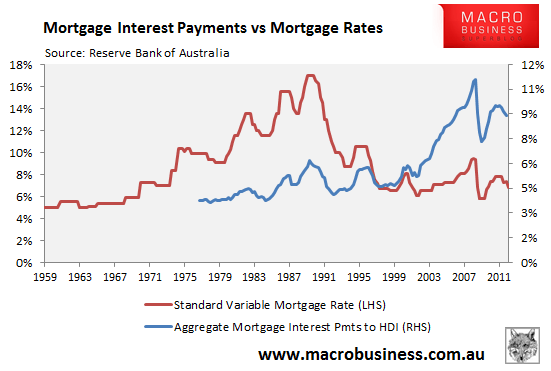
There has been a spate of articles recently making some spurious claims about housing affordability in Australia. Yesterday, two articles caught my eye.
The first, by the AFR’s David Basanese argued that mortgage repayments as a percentage of disposable income were around 6% below the average since mid-1986. My colleague, Houses & Holes, debunked Basanese’s claim by citing HIA and RBA data showing that housing affordability, while much improved, is still poor relative to historical experience.
The second group of articles that appeared yesterday (for example here) cited commentary by accounting and wealth advisory group, Chan & Naylor, arguing that first home buyers should move fast and secure a property before they miss out forever! While there is a lot that is wrong with Chan & Naylor’s arguments, I found the following particularly spurious:
“According to a recent study by KPMG, 60 years ago house values in Australia stood at roughly seven times the yearly household income, and today that figure stands at a very close 6.9”.
Here, Chan & Naylor have cited analysis by KPMG’s Bernard Salt, which uses highly questionable income data to arise at his price-to-income comparison. Salt also bizarrely argues that homes are just as affordable as they used to be because we have more dual breadwinners and households are working longer hours (I would have thought having to work longer and harder to buy something makes it less affordable?).
Although I have debunked Salt’s claims about housing affordability previously, I thought it would be worth presenting some long-run data that provide some history on Australian house prices, incomes and affordability.
The first chart below shows the growth of Australian house prices since 1950 against the growth of average weekly earnings (AWE), whose dataset dates back to 1969:

As you can see, house prices appeared to track income growth until the late-1980s, when they began to diverge. From 1998, house prices rocketted, whereas AWE grew far more slowly. Based on the above data alone, Salt’s claim that housing is just as affordable now as in 1950 is looking very shaky.
But what about the impact of lower interest rates? Well the below chart plots average variable mortgage rates (starting in 1959) against the ratio of mortgage interest payments to household disposable incomes (starting in 1977):

Based on RBA data, mortgage rates were lower in the late-1950s than currently. Further, although nominal mortgage rates were higher in the 1970s (real mortgage rates were actually negative), aggregate mortgage interest payments consumed less than half as much household disposable income than is the case currently, despite households today having more dual breadwinners and working longer hours.
Whichever way the data is cut, Salt’s claim that housing today is just as affordable as in generations gone by does not hold up to scrutiny.
Perhaps this is why Commsec published research in 2010 arguing that households are having to work nearly three times as many hours to pay-off the family home as compared to those in 1960.
As always, take claims of housing affordability with a big spoonful of salt.
Twitter: Leith van Onselen. Leith is the Chief Economist of Macro Investor, Australia’s independent investment newsletter covering trades, stocks, property and yield. Click for a free 21 day trial.

